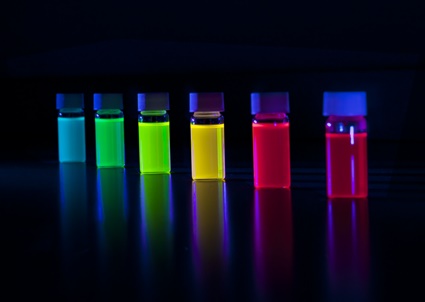Using Cadmium-Free Quantum Dot LCD Backlight Films
Cadmium-free quantum dots are setting the benchmark for stunning digital color displays while reducing health and safety concerns regarding the implementation of cadmium (Cd) in quantum dot manufacture.
Cadmium is a toxic metal that is widely-applied in the production of electronic components, including pigments and batteries. A part of the quantum dots manufactured for commercial uses in electronic displays are based on cadmium selenide (CdSe) technology, which is temporarily exempt from RoHS regulations. Anticipating that this will elapse during 2019, Avantama has developed a patented method of producing high-quality cadmium-free quantum dots that are fully RoHS compliant, allowing for greater industry stability during this period of LCD display innovation.

Currently, quantum dots are implemented in display technologies by integrating them into the existing LCD-backlit display structure. A backlight of LEDs emits monochromatic blue light into a backlight film comprising layers of red and green quantum dots. These photo-luminescent nanoparticles are excited by the absorbed blue light, causing them to emit light of specific wavelengths in turn. Established displays using this method exhibit exceptional wide color gamut, with the potential to redefine the display market in the future – assuming the benefits of producing cadmium-free quantum dots for backlight films translate to a significant shift in display manufacture.
Quantum Dots Composition and Performance
Avantama’s cadmium-free quantum dots are based on a cesium lead halide, reducing toxicity concerns for workers responsible for quantum dot product manufacture and transport. Implemented as quantum dot backlight films, they also display significant aesthetic performance improvements over quantum dots manufactured by other means. Compared to quantum dots composed of traditional CdSe, our cadmium-free quantum dot backlight films show an improved photo-luminescence quantum yield (PLQY) of 5%, and as much as 25% when compared with quantum dots composed of indium phosphide (InP).
InP quantum dots are another alternative to those produced with CdSe, and while they are RoHS compliant, their optical properties are considerably reduced in comparison to those of cadmium-free quantum dots manufactured from cesium lead halide. Market-leading displays using InP quantum dot backlight films offer unexceptional Rec. 2020 coverage of less than 70%. Cesium lead halide quantum dots meanwhile are capable of extreme emission peak wavelength, with full width at half maximum of ~ 20 nm for green quantum dots and ~ 30 nm for red. Despite their vastly superior performance potential, cadmium-free quantum dots from Avantama also exhibit significantly greater energy saving potential over InP quantum dot films, and substantially decreased costs per TV area.
Cadmium-free quantum dots chemically composed of cesium lead halide offer far-reaching and fundamental benefits to the manufacture of UHDTVs, by complying with restrictions on hazardous substances thus avoiding future liability for manufacturers with widespread brand awareness. They are also substantially cost-efficient due to the relative availability of the chemical components, and as discussed, they offer unmatched performance quality when it comes to display brightness and color purity.
Cadmium-free Quantum Dots from Avantama
Avantama are experts in the development and manufacture of efficient materials suitable for the electronic industry. Our patented method of producing cadmium-free quantum dots is unprecedented, resulting in the most cost-efficient and highest performing quantum dot technology available.
We aim to provide a cadmium-free quantum dot backlight film that is between three and six times cheaper than any currently available on the commercial market, providing distinct benefits to manufacturers and consumers alike.
If you would like any more information about our cadmium-free quantum dots for LCD backlight films, please contact us.